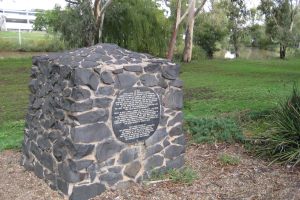About
This Cactoblastis Memorial Cairn located in Dalby, Australia, commemorates the triumph of a moth over the mass infestation of the prickly pear plant in Australia.
The prickly pear plant was first introduced to Australia by the colonists of the First Fleet in 1788. Various other varieties of the plant were subsequently introduced which thrived and soon ran wild. The plants created dense thickets which left the land it covered unusable. By 1920, prickly pear had infested over 24 million hectares of land—an area larger than the land mass of the United Kingdom. It was one of the world's greatest biological invasions.
In 1901, Queensland offered a cash reward to anyone who could find an effective solution to the prickly pear problem. Various methods were tested, including the use of toxic chemicals such as sulphuric acid and arsenic, but nothing was effective. By the 1920s, 400,000 hectares of land was being lost every year.
In 1913, the Prickly Pear Travelling Commission was formed to search for an answer. A team of biologists visited North and South America where the plant is indigenous. The commission identified a number of natural controls in these areas, including insects and fungal diseases. But the outbreak of World War I put their testing of these solutions on hold. After the war, an experimental station known as the Bug Farm was set up in Chinchilla, Australia, to work on the solution.
Enter our hero: a South American supermoth with the scientific name Cactoblastis cactorum. Native to Argentina, these moths lay their eggs on the prickly pear plant. The larvae then burrow into the plant to feed on the interior—they can destroy an entire plant within weeks.
In 1925, a small number of Cactoblastis moth eggs were imported from South America. After biologists had observed the moths' feeding habits to ensure they wouldn't attack plants other than the prickly pear, the first moths were released into the wild in 1926. Millions of eggs were distributed throughout prickly-pear-infested areas, followed by a further 2.2 billion between 1927 and 1931.
The results were astonishing. By 1932, the moth larvae had destroyed most of the pricky pear opening up almost 7 million hectares of uninhabitable and abandoned land. Within 10 years, the insects had destroyed all the dense masses of prickly pear. While prickly pear has not been fully eradicated from Australia, it is nowhere near as dominant as it was in the 1920s.
The control of prickly pear by the Cactoblastis moth remains one of the world's most successful examples of biological control. As a tribute to the success of the program, the Cactoblastis Memorial Hall was built near Chinchilla, Australia in 1936.
Related Tags
Published
June 16, 2022




































